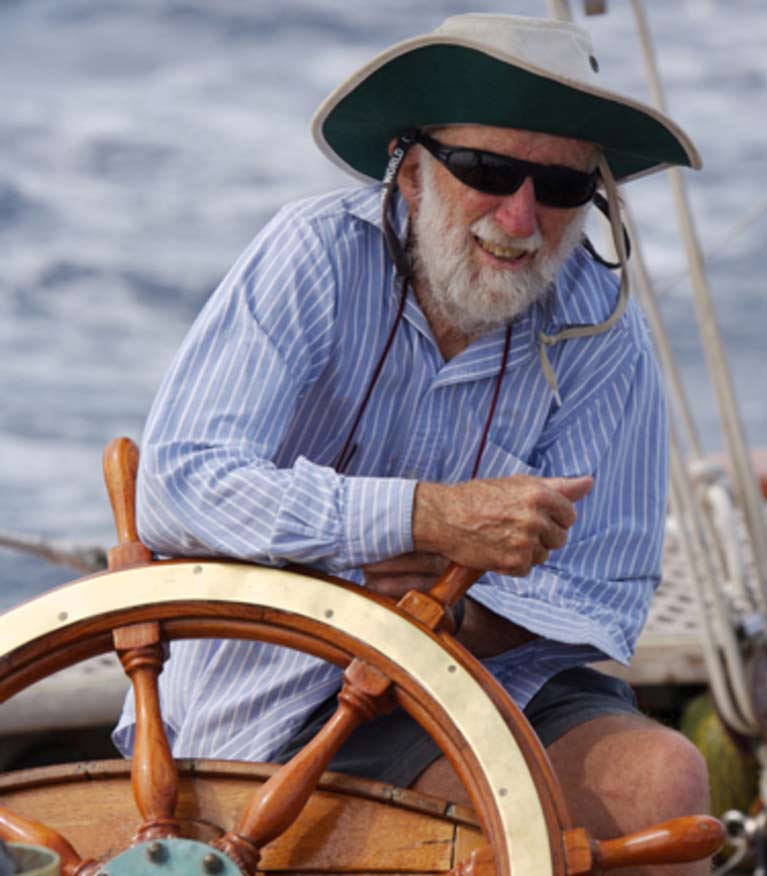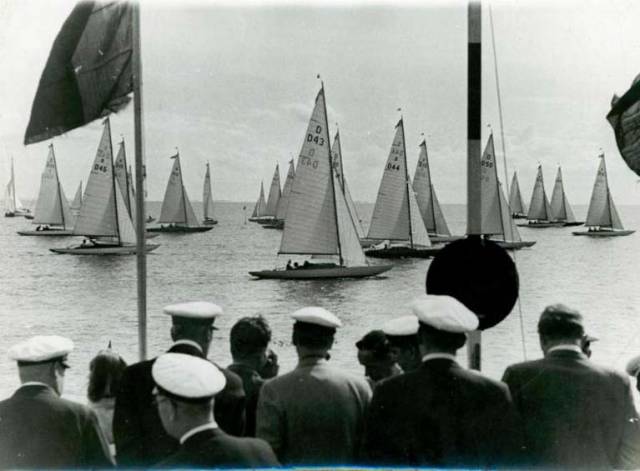Glandore Harbour's Don Street has entered Dragon IRL15, which at 78 years old is thought to be the oldest Dragon still racing, into the 90th-anniversary celebration regatta for the class in Italy.
Street will race against other historic Dragons including ESP1 owned by German Gill-Mendoza March, GER16 owned by Dr Dirk Pramann and Vittorio Boccolini’s EPS2.
As Afloat's WM Nixon wrote earlier this month, the Dragon is among Ireland’s classic sailing boats that appear to be ageless.
With five months still to go 130 entries from 26 nations and 4 continents have already registered, and this number is expected to grow as the event approaches. Alongside the modern Dragons, a large fleet of Classics is expected.
 The legendary Don Street – at 89, he races an 86-year-old Dragon with as much enthusiasm as ever
The legendary Don Street – at 89, he races an 86-year-old Dragon with as much enthusiasm as ever
The International Dragon is one of the most sought after one design keelboats in the world and 2019 sees the class celebrate its 90th anniversary. To mark this extraordinary milestone the International Dragon Association is partnering with the Yacht Club Sanremo, Italy, to create a truly exceptional Gala Regatta, bringing together Dragons and Dragon sailors from around the globe and across the eras for a spectacular week long birthday party.
Sanremo, the City of Flowers on the Italian Riviera, has long been a popular venue with the Dragon fleet. The club has a world-renowned reputation for delivering stylish events and top flight competition and is pulling out all the stops for this unique celebration. The Dragon 90th Anniversary Regatta will take place from 5 to 13 October 2019 and will combine an exciting and innovative racing programme with some truly fabulous parties.
International Dragon Association (IDA) Chairman Vasily Senatorov looks forward to the regatta saying; “I invite all Dragon sailors and friends from around the globe to attend our 90th Anniversary Regatta and help us celebrate. The IDA, the Yacht Club Sanremo and our sponsor partners are creating an event that will live in our memories forever, and we want all our friends to join us.”
There are many milestones to celebrate as the Dragon turns 90. The boat was designed by Johan Anker in 1929 for a competition being run by the Royal Yacht Club of Gothenburg to find a new two-berth weekend cruiser suitable for sailing the islands and fjords of Scandinavia. The design not only won the competition but rapidly gained huge popularity thanks to her beautiful lines and wonderful sailing performance.
In 1933 AH Ball of the Royal Clyde Yacht Club saw a Dragon while cruising in Scandinavia and fell in love with the design. He obtained a set of plans and persuaded the Clyde clubs, who were looking for a small boat to replace the large and expensive pre-first world war classes, to adopt the class and the first six British Dragons were built by McGruer’s at Clynder at a cost of £220 apiece. The success of the class was immediate and in 1936 the Clyde Yacht Club’s Conference presented a new trophy for international competition called the Gold Cup, which remains the Dragon’s most coveted annual trophy to this day.
As her international following grew, the Dragon was adopted as an Olympic Class for the 1948 London/Torquay Games and she remained an Olympic class until the Munich/Kiel Games of 1972. For some classes deselection for the Olympics sounds a death knell, but for the Dragon is was to be the start of a new era of even greater success.
The International Dragon Association (IDA) has always had the foresight to encompass change whilst fiercely protecting its essential one design philosophy. There have been many changes over the years that have kept the class current, but perhaps the biggest of these was the transition to fibreglass construction. Børressen of Denmark had built large numbers of successful wooden Dragons and Børge Børressen, who won the Dragon Gold Cup for Denmark on the Clyde in 1967, collaborated with Lloyds Register of Shipping to produce the specifications for a new GRP Dragon, which were adopted by the IDA in 1972. So cleverly devised were the new rules that the original wooden and new GRP Dragons could race on a level playing field and the longevity of the class was assured.
The Dragon has been closely associated with European Royalty over the years. In 1948 the Island Sailing Club of Cowes presented the then Princess Elizabeth and Duke of Edinburgh with a Dragon on the occasion of their wedding. The Duke was a most active member of the class for many years and presented a number of international trophies which are still raced for today. HM King Constantine and members of the Dutch, Norwegian and Danish royal families have also owned and raced Dragons, often with considerable success.
Today the Dragon remains the preeminent three-man international keelboat class. Continued careful rule management has ensured that the boat remains as much of a head turner today as ever, whilst at the same time incorporating the very latest racing technology. From the outset she attracted top flight sailors who fell in love with sailing her, and this is as true today as it ever was. Her easy performance and good manners mean that she also continues to appeal to family sailors and those simply seeking a superb yacht, just as she did to those young people who purchased the first Dragons for cruising back in the late 1920s.
The 90th Anniversary Regatta will celebrate all these elements of the Dragon’s long life and more, including the extraordinary camaraderie for which the fleet is famous. The programme will include a number of special races such as a Lady helmsman’s race, a race for Junior crews where the total age of crew is to be under 100 years and the skipper must be born after 1986, a Masters race where the total age of the crew must be over 180 years, a Family crews race in which all crew members must be related, and a Champion of Champions race for winners and medallists of Olympic Games, World and European Championships and World Cup in any class and the Dragon Gold Cup.
For the main races, the fleet will be split into groups for a preliminary round-robin series, followed by finals for Gold, Silver and Bronze fleets. The on-water highlight of the regatta will be the 90th Anniversary Race in which the entire assembled fleet will race as one from a single start line. The last time such a race was run was the Dragon 75th Anniversary Regatta in St Tropez when some 275 Dragons came to the line for a race that will always live in the memory of all who participated.
The shoreside celebrations will be lavish with post sailing parties daily featuring typical Italian produce, music and fun, a spectacular Gala Birthday Party, to be held in the stunning Art Deco Victory Morgana Bay waterside restaurant, and very special closing prize giving. As well as those racing the regatta will attract many long-standing Dragon friends and family. Spectator boats will be available for those who wish to watch the racing and the Yacht Club Sanremo will provide a superb base from which all can enjoy the regatta. The event will be supported by the City of Sanremo and the Royal Hotel, Sanremo.
“The Yacht Club Sanremo its enthusiastic for this great event. The Dragon class has, for more than ten years, been a core class for the club and to be invited to organise this great event is a big honour. We will work hard to make this event a fantastic "festival" for the Dragonist.” - Umberto Zocca di Montelupo, Yacht Club Sanremo






























































